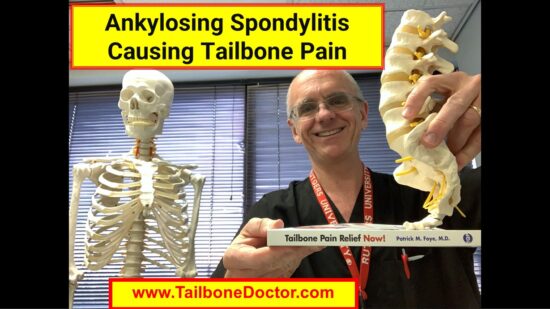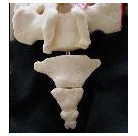Here is the transcript from Dr. Foye’s video about Ankylosing Spondylitis and Coccyx Pain, Tailbone Pain. The actual video is below.
Let’s talk about Ankylosing Spondylitis and coccyx pain, or tailbone pain.
I’m Dr. Patrick Foye. I’m an M.D. (or medical doctor) and Director of the Coccyx Pain Center (Tailbone Pain Center) here in the United States, online at www.TailboneDoctor.com.
Ankylosing spondylitis: what does the term mean?
Ankylosing refers to joints that have stiffness or rigidity or even fusion from between one bone and the next across a joint or across a series of joints.
So that’s the ankylosis or ankylosing.
Spondy refers to spine.
So everywhere from the cervical spine up at the neck to the coccygeal spine down at the coccyx or tailbone.
So that’s the spine from top to bottom.
And “-itis” at the end of a word refers to that there may be a component of inflammation.
So ankylosing spondylitis is a condition where the spine has rigidity or stiffness or decreased movement or fusion… along with potential inflammation.
Now because the coccyx is part of the spine (it’s the lowest part of the spine) it’s not surprising that the coccyx can be involved in ankylosing spondylitis.
So you can have stiffness or rigidity or decreased movement at the coccyx.
And the reason that creates a problem is that… here’s a plastic model of the spine… lumbar spine here then the sacrum and then the coccyx here down at the bottom.
And if we look from the side you can see when you sit and you’re sitting on a chair for example… the coccyx is supposed to flex itself slightly forward by about 20 degrees so it tucks itself a little bit into the pelvis, so it’s not hitting as directly against the chair.
If the coccyx is rigid or stiff or fused and fails to flex forward, then it’s going to hit into the chair, have more pressure on the tailbone, and that can be a source of coccyx pain or tailbone pain.
So, the way to diagnose that is by sitting-versus-standing x-rays.
But, unfortunately, very few radiology centers are familiar or experienced with doing sitting-versus-standing x-rays.
Those are x-rays that are done to see how much movement there is at the tailbone when you sit, and sit and lean back for example which tends to put pressure onto the tailbone.
But that would be the way to officially diagnose whether there is decreased mobility at the coccyx in a condition like ankylosing spondylitis.
If you’re interested in more information about coccyx pain you can certainly get my book on Amazon. It’s “Tailbone Pain Relief Now!”.
or if you’re interested in more information go on my website… that is www.TailboneDoctor.com.
Or if you’re interested to come and see me in-person again just go to www.TailboneDoctor.com and there’ll be lots of information for you there.
So, I hope that’s helpful at explaining how Ankylosing Spondylitis can include the coccyx and can cause coccyx pain.
Okay, bye bye now.
Here is the video: https://youtu.be/8lWxlhMy4W0
Here is the screenshot from the video:

COME FOR RELIEF: For more information on coccyx pain, or to be evaluated in-person by Dr. Foye’s Coccyx Pain Center in the United States, go to: www.TailboneDoctor.com
– Patrick Foye, M.D., Director of the Tailbone Pain Center, New Jersey, United States.
- Coccygectomy: Expected Recovery and Return to Work after surgery for coccyx pain, tailbone pain. - November 28, 2023
- PRP Platelet Rich Plasma or Prolotherapy for Tailbone Pain, Coccyx Pain - October 25, 2023
- Reasons for Normal X-rays and MRI Despite Tailbone Pain, Coccyx Pain - October 3, 2023

